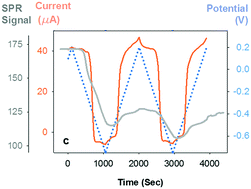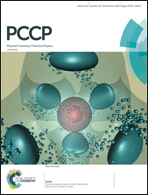Application of electrochemical surface plasmon resonance (ESPR) to the study of electroactive microbial biofilms†
Abstract
Electrochemical surface plasmon resonance (ESPR) monitors faradaic processes optically by the change in refractive index that occurs with a change in redox state at the electrode surface. Here we apply ESPR to investigate the anode-grown Geobacter sulfurreducens biofilm (GSB), a model system used to study electroactive microbial biofilms (EABFs) which perform electrochemical reactions using electrodes as metabolic electron acceptors or donors. A substantial body of evidence indicates that electron transfer reactions among hemes of c-type cytochromes (c-Cyt) play major roles in the extracellular electron transfer (EET) pathways that connect intracellular metabolic processes of cells in an EABF to the electrode surface. The results reported here reveal that when the potential of the electrode is changed from relatively oxidizing (0.40 V vs. SHE) to reducing (−0.55 V vs. SHE) and then back to oxidizing, 70% of c-Cyt residing closest to the biofilm/electrode (within hundreds of nm from the electrode surface) appear to remain trapped in the reduced state, requiring as long as 12 hours to be re-oxidized. c-Cyt storing electrons cannot contribute to EET, yet turnover current resulting from cellular oxidation of acetate coupled with EET to the electrode surface is unaffected. This suggests that a relatively small fraction of c-Cyt residing closest to the biofilm/electrode interface is involved in EET while the majority store electrons. The results also reveal that biomass density at the biofilm/electrode interface increases rapidly during lag phase, reaching its maximum value at the onset of exponential biofilm growth when turnover current begins to rapidly increase.

- This article is part of the themed collection: 2018 PCCP HOT Articles


 Please wait while we load your content...
Please wait while we load your content...
